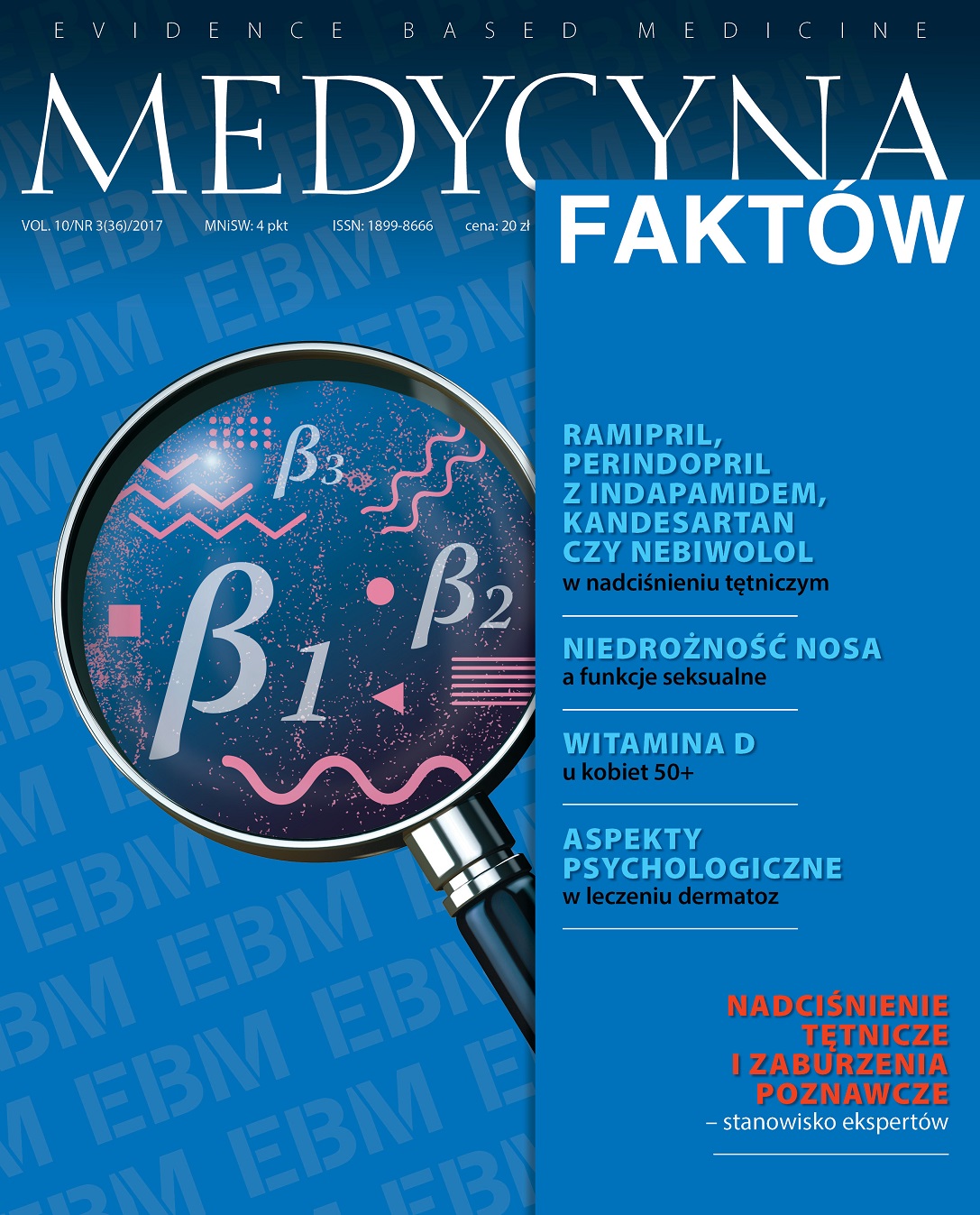Kandesartan ? najsilniejszy bloker receptora AT1 Artykuł przeglądowy
##plugins.themes.bootstrap3.article.main##
Abstrakt
Aktywacja osi renina?angiotensyna?aldosteron leży u podstaw wielu chorób sercowo-naczyniowych, m.in. nadciśnienia tętniczego i niewydolności serca. Sartany są grupą leków często stosowanych w praktyce klinicznej, ich działanie polega na blokowaniu receptora AT1 dla angiotensyny II. Wiele badań wskazuje, że w tej grupie leków nie występuje efekt klasy i poszczególni przedstawiciele istotnie różnią się między sobą. W poniższym artykule przedstawiono cechy wyróżniające kandesartan na tle innych blokerów receptora AT1.
##plugins.themes.bootstrap3.article.details##
Jak cytować
Grabowski , M., & Januszkiewicz , Łukasz. (2017). Kandesartan ? najsilniejszy bloker receptora AT1 . Medycyna Faktów , 10(3(36), 201-204. Pobrano z https://journalsmededu.pl/index.php/jebm/article/view/2123
Numer
Dział
Artykuły
Copyright ? by Medical Education. All rights reserved.
Bibliografia
1. Aulakh G.H., Sodhi R.K., Singh M.: An update on non-peptide angiotensin receptor antagonists and related RAAS modulators. Life Sciences 2007; 81: 615-639.
2. Joint National Committee. Sixth National Report of the Joint National Committee on Prevention, Detection, Evaluation and Treatment of High Blood Pressure (JNC VI). Arch. Intern. Med. 1997; 157: 2413-2446.
3. McMurray J.J., Ostergren J., Swedberg K. et al.: Effects of candesartan in patients with chronic heart failure and reduced left-ventricular systolic function taking angiotensin-converting-enzyme inhibitors: the CHARM-Added trial. Lancet 2003; 362: 767-771.
4. Granger C.B., McMurray J.J., Yusuf S. et al.: Effects of candesartan in patients with chronic heart failure and reduced left-ventricular systolic function intolerant to angiotensin-converting-enzyme inhibitors: the CHARM-Alternative trial. Lancet 2003; 362: 772-776.
5. Yusuf S., Pfeffer M.A., Swedberg K. et al.: Effects of candesartan in patients with chronic heart failure and preserved left-ventricular ejection fraction: the CHARM-Preserved Trial. Lancet 2003; 362: 777-781.
6. Papademetriou V., Farsang C., Elmfeldt D. et al.: Stroke prevention with the angiotensin II type 1-receptor blocker candesartan in elderly patients with isolated systolic hypertension: the Study on Cognition and Prognosis in the Elderly (SCOPE). J. Am. Coll. Cardiol. 2004; 44: 1175-1180.
7. Schrader J., Lu?ders S, Kulschewski A. et al.: The ACCESS Study. Evaluation of Acute Candesartan Cilexetil Therapy in Stroke Survivors. Stroke 2003; 34: 1699-1703.
8. Hansson L.: The relationship between dose and anti-hypertensive effect for different AT1-receptor blockers. Blood Press. 2001;10(supl. 3): 33-39.
9. Bakris G., Gradman A., Reif M. et al.: Antihypertensive efficacy of candesartan in comparison to losartan: the CLAIM study. J. Clin. Hypertens. 2001; 3: 16-21.
10. Lacourci?re Y., Asmar R.: A comparison of the efficacy and duration of action of candesartan cilexetil and losartan as assessed by clinic and ambulatory blood pressure after a missed dose, in truly hypertensive patients. A placebo-controlled, forced titration study. Am. J. Hypertens. 1999; 12: 1181-1187.
11. Himmelmann A., Keinanen-Kiukaanniemi S., Wester A. et al.: The effect duration of candesartan cilexetil once daily, in comparison with enalapril once daily, in patients w ith mild to moderate hypertension. Blood Press. 2001; 10: 43-51.
12. Julius S., Nesbitt S.D., Egan B.M. et al.: Feasibility of treating prehypertension with an angiotensin-receptor blocker. N. Engl. J. Med. 2006; 354: 1685-1697.
2. Joint National Committee. Sixth National Report of the Joint National Committee on Prevention, Detection, Evaluation and Treatment of High Blood Pressure (JNC VI). Arch. Intern. Med. 1997; 157: 2413-2446.
3. McMurray J.J., Ostergren J., Swedberg K. et al.: Effects of candesartan in patients with chronic heart failure and reduced left-ventricular systolic function taking angiotensin-converting-enzyme inhibitors: the CHARM-Added trial. Lancet 2003; 362: 767-771.
4. Granger C.B., McMurray J.J., Yusuf S. et al.: Effects of candesartan in patients with chronic heart failure and reduced left-ventricular systolic function intolerant to angiotensin-converting-enzyme inhibitors: the CHARM-Alternative trial. Lancet 2003; 362: 772-776.
5. Yusuf S., Pfeffer M.A., Swedberg K. et al.: Effects of candesartan in patients with chronic heart failure and preserved left-ventricular ejection fraction: the CHARM-Preserved Trial. Lancet 2003; 362: 777-781.
6. Papademetriou V., Farsang C., Elmfeldt D. et al.: Stroke prevention with the angiotensin II type 1-receptor blocker candesartan in elderly patients with isolated systolic hypertension: the Study on Cognition and Prognosis in the Elderly (SCOPE). J. Am. Coll. Cardiol. 2004; 44: 1175-1180.
7. Schrader J., Lu?ders S, Kulschewski A. et al.: The ACCESS Study. Evaluation of Acute Candesartan Cilexetil Therapy in Stroke Survivors. Stroke 2003; 34: 1699-1703.
8. Hansson L.: The relationship between dose and anti-hypertensive effect for different AT1-receptor blockers. Blood Press. 2001;10(supl. 3): 33-39.
9. Bakris G., Gradman A., Reif M. et al.: Antihypertensive efficacy of candesartan in comparison to losartan: the CLAIM study. J. Clin. Hypertens. 2001; 3: 16-21.
10. Lacourci?re Y., Asmar R.: A comparison of the efficacy and duration of action of candesartan cilexetil and losartan as assessed by clinic and ambulatory blood pressure after a missed dose, in truly hypertensive patients. A placebo-controlled, forced titration study. Am. J. Hypertens. 1999; 12: 1181-1187.
11. Himmelmann A., Keinanen-Kiukaanniemi S., Wester A. et al.: The effect duration of candesartan cilexetil once daily, in comparison with enalapril once daily, in patients w ith mild to moderate hypertension. Blood Press. 2001; 10: 43-51.
12. Julius S., Nesbitt S.D., Egan B.M. et al.: Feasibility of treating prehypertension with an angiotensin-receptor blocker. N. Engl. J. Med. 2006; 354: 1685-1697.
